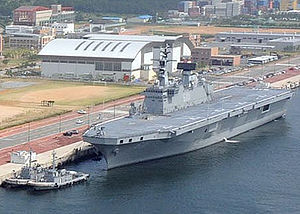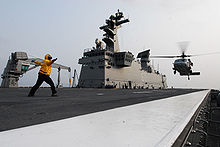- Dokdo class amphibious assault ship
-

ROKS Dokdo (LPH 6111) moored at Busan in August 2009.Class overview Name: Dokdo Class LPH Builders: Hanjin Heavy Industries Operators:  Republic of Korea
Republic of KoreaCost: KRW 325,770,000,000 (2005)[1] Planned: 4 Active: 1 General characteristics Tonnage: 14,300 tons (empty) / 18,800 tons (full) Length: 199 m (653 ft) Beam: 31 m (102 ft) Draught: 7 m (23 ft) Propulsion: 4 S.E.M.T. Pielstick 16 PC2.5 STC Diesel engine Speed: 23 knots (43 km/h) maximum
18 knots (33 km/h) cruisingBoats and landing
craft carried:2 LSF-II or LCAC Capacity: Up to 200 vehicles Troops: 720 marines, 6 tanks, 7 amphibious assault vehicles Crew: 700 Sensors and
processing systems:SMART-L air search radar,MW08 surface search radar,AN/SPS-95K navigation radar, TACAN,VAMPIR-MB optronic sight Electronic warfare
and decoys:ESM/ECM:SLQ-200(v)5K SONATA, Chaff launcher Armament: Two Goalkeeper CIWS, One RIM-116 Rolling Airframe Missile Aircraft carried: Up to 15 helicopters (15 UH-60 Black Hawk or 10 SH-60F Ocean Hawk helicopters)
2 LCACs (Landing Craft Air Cushioned)Aviation facilities: Flight deck and hangar ROKS Dokdo (LPH 6111) is the lead ship of the "LPX" class of amphibious landing ships of the Republic of Korea Navy, launched on 12 July 2005 at the shipyard of Hanjin Heavy Industries & Constructions Co. in Busan.
Designed by Hanjin Heavy Industries, the requirements for the amphibious landing ships were to enhance Korea's current amphibious operation capability, both in terms of assault and military operations other than war (MOOTW) type operations.
The ROKS Dokdo is also the largest helicopter landing ship in Asia, with one of the fastest maximum speeds in the world in regards of heavy amphibious assault ships.
Contents
Development
Specifications
 US Navy MH-60S landing on the flight deck of ROKS Dokdo (LPH 6111).
US Navy MH-60S landing on the flight deck of ROKS Dokdo (LPH 6111).
The LPX is a versatile amphibious warfare ship, and includes a well deck to accommodate Amphibious Assault Vehicles (AAVs) and two Landing Craft Air Cushion (LCAC), the first of which (LSF 631) was acquired in April 2007. The ship is 199 metres long, 31 metres wide, with a 14,000 ton (empty), or 18,000 ton (full) displacement.
As a high-speed amphibious ship, LPX was based on the concept of "over-the-horizon assault." As the name indicates, the "over-the-horizon assault" comprises a military operation in which an amphibious landing operation is conducted with high-speed air-cushioned vehicles and helicopters from beyond the horizon, where they can't be easily detected or attacked by the enemy. The conventional LST (landing ship tank) has to approach the coastline for landing, at the risk of being fired upon by the enemy.
The LPX can carry 720 marines (+300 crew members), 10 tanks, 10 trucks, 7 AAVs, three field artillery pieces, 10 helicopters, and two LCAC hovercraft capable of landing on enemy shores doing 40 knots (74 km/h)—a mix that enables it to launch troop landings from both sea and air.
Self-defense armament includes the RIM-116 Rolling Airframe Missile system. The Goalkeeper Close-in weapon system (CIWS) was purchased in January 2003 from Thales, at per-set price of 13,000,000,000 won (roughly $15,000,000).
The flight surface is also sprayed with urethane, which can support VTOL jets, like Harriers. South Korea is considering the purchase of F-35B fighters to operate from its Dokdo class ships.[2] As an interim measure some Harriers may be purchased or leased from RAF surplus, as Harriers are operated by USMC in Okinawa training and logistics issues can be easily managed with US assistance, or even with the creation of a joint US-Korean-Japan Harrier squadron based in Okinawa.[citation needed]
Dokdo is similar in size to the Spanish Navy's current aircraft carrier SPS Príncipe de Asturias and the Thai Navy's HTMS Chakri Naruebet.
Ships of the Class
Name Pennant Builder Commissioned Status ROKS Dokdo LPH 6111 Hanjin 3 July 2007 Active ROKS Marado LPH Hanjin Under Construction ROKS Baengnyeongdo LPH Hanjin ROKS ? LPH Hanjin The Dokdo Class of LPH are named after Korean islands deemed important or symbolic to the ROK Navy. ROKS Dokdo (LPH-6111) is named after the Dokdo islets, a small group of islands under Korean administration.
The ROK Navy has plans to develop another similar ship by 2010. This unit will be named after Marado Island, which is located 11 kilometres offshore from Moseulpo harbor of Jeju. Marado Island is commonly thought of as being both the ending and beginning point of Korea. Today a monument stands there recognizing it as the southernmost point of the country.
The third unit is to be named after Baengnyeong Island, which is located in the Yellow Sea near the disputed Northern Limit Line (NLL) with North Korea. Baekryeong Island is the territory administered by South Korea that is closest to the NLL. It was an important military base and the site of fierce combat during the Korean War.
Future plans
 ROKS Dokdo (LPH 6111) assisting search and rescue after the ROKS Cheonan sinking.
ROKS Dokdo (LPH 6111) assisting search and rescue after the ROKS Cheonan sinking.
Some proposed uses for the ship include UN peacekeeping operations and disaster relief. For this reason, the LP-X is expected to usher in a new era of expanded Korean naval activity, since it can be used for relief, transport, and other peacetime activities.
In a speech delivered in March 2001, Kim Dae Jung stated that his administration was aiming to build a navy that "will defend the national interests in the five oceans and perform a role in defending world peace." By the year 2020, the ROK Navy plans to deploy two or three rapid response fleets, each comprising 1 LPX, 2 KDX-III, 4 KDX-II, 1 KDX-I and possibly a number of FFX frigates and two or three SSX submarines.
See also: Military of South KoreaROK Navy's Rapid Response Fleet:
- Dokdo class LPH (Flagship)
- King Sejong the Great class destroyer (KDX-III) Aegis Combat System
- KDX-II
- KDX-I
- Type 214 submarine
References
External links
Destroyers Sejong the Great · Yulgok Yi I · Yu Seong-ryong
Chungmugong Yi Sunshin · Munmu the Great · Dae Joyeong · Wang Geon · Kang Gamchan · Choi Young
Gwanggaeto the Great · Eulji Mundeok · Yang Manchun
Submarines Sohn Wonyil · Jeong Ji · An Chunggun
Chang Bogo · Lee Chun · Choi Moosun · Park Wi · Lee Jongmoo · Jung Woon · Lee Sunshin · Na Daeyong · Lee Eokgi
Dolgorae-classROKS SSM-052 ~ 053
Frigates Ulsan · Seoul · Chungnam · Masan · Gyeongbuk · Jeonnam · Jeju · Busan · Cheongju
Corvettes Gunsan · Gyeongju · Mokpo · Gimcheon · Chungju · Jinju · Yeosu · Jinhae · Suncheon · Iri · Wonju · Andong · Bucheon · Seongnam · Jecheon · Daecheon · Sokcho · Yeongju · Namwon · Gwangmyeong · Sinseong · Gongju
Anyang
Patrol ships Yoon Youngha
ROKS PKM-2xx ~ 3xx
Amphibious
warfare shipsDokdo-class LPHDokdo
Gojunbong · Birobong · Hyangnobong · Seonginbong
Solgae-class LSFROKS LSF-621 ~ 623, 631 ~ 632
Mine counter
measures vesselsWonsan
Ganggyeong · Gangjin · Goryeong · Gimpo · Gochang · GeumhwaYangyang · Ongjin · HaenamAuxiliary ships AOECheonji · Daecheong · Hwacheon
Cheonghaejin
Pyeongtaek-class ATSPyeongtaek · Gwangyang
Sincheonji-class AGSSincheonji
Sinsegi-class AGSSinsegi
Dadohae-class ASLDadohae
Categories:- Helicopter carrier classes
- Amphibious warfare vessel classes
- Dokdo class amphibious assault ships
- Active amphibious warfare vessels of South Korea
Wikimedia Foundation. 2010.

